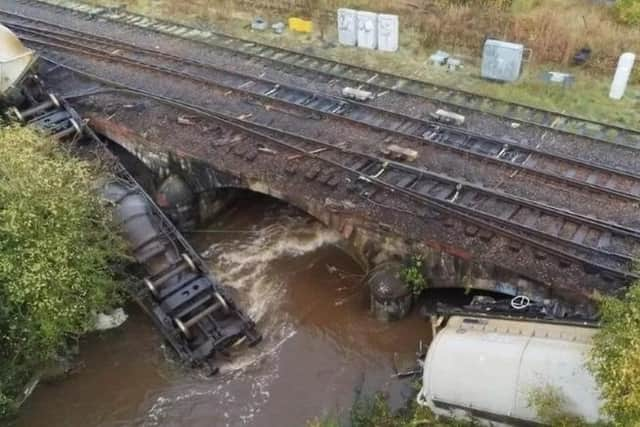Report into freight train derailment that closed Settle to Carlisle line for seven weeks finds accident was caused by 'wheel that stopped turning'
The Rail Accident Investigation Branch this week published a report into the incident on October 19 last year, when five of the cement train’s wagons overturned at Petteril Bridge Junction in Carlisle. As a result, part of the famously scenic Settle to Carlisle line through the Yorkshire Dales was closed for seven weeks, with trains unable to travel between Skipton and Carlisle.
The freight train was travelling from Clitheroe to Glasgow, and the defective wagon ended up rupturing and landing upside down in the River Petteril.
Advertisement
Hide AdAdvertisement
Hide AdThe report reads: “The derailment occurred because one set of wheels on the ninth wagon in the train stopped rotating during the journey. These wheels had stopped rotating up to 55 miles (88 km) before the derailment and continued to slide along the railhead causing considerable damage to the profile of the wheel treads. This meant that the wheels were unable to safely negotiate a set of points just before Petteril Bridge Junction, damaging them and causing the ninth wagon to become derailed. Five of the wagons derailed due to the consequent track damage and two of them fell off the side of the bridge.


"The initial wheel slide was probably the result of a normal brake application made in low adhesion conditions that were not abnormal for the route at the time of year. The wheel slide continued because the adhesion between the wheels and the rails was then insufficient for the wheels to restart rotation.
"The non-rotating wheels were not identified by the signallers on the route, nor by the train driver or any engineered system, meaning that the train was not stopped before it reached Petteril Bridge Junction.”
Minor recommendations were made by the RAIB’s inspectors relating to both drivers and signallers examining trains during their journeys and stopping trains for further checks if necessary.
The Victorian bridge was severely damaged during the incident and the recovery job was described as ‘complex’ by Network Rail. Giant vacuums had to be used to remove the cement.
